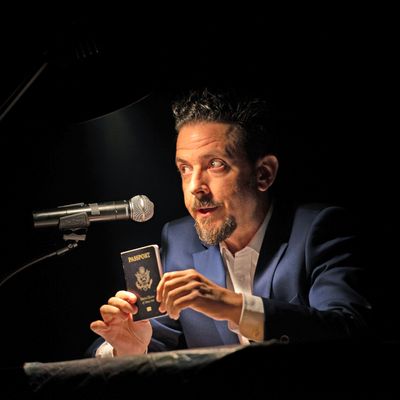
It‚Äôs a risky thing to build a play around a list, especially a long list. It‚Äôs human nature to want to check things off, and if you‚Äôre not extremely dexterous in your storytelling ‚Äî compelling enough to turn your ‚ÄúA Play in 21 Scenes,‚Äù say, into a play in a single story ‚Äî you‚Äôre going to end up with an audience that‚Äôs mentally plodding through, counting off how many scenes down and how many to go,¬Ýinstead of galloping enthusiastically alongside you. (If you‚Äôve ever been to a musical where you kept surreptitiously checking the program to see how many songs were left, then you know what I‚Äôm talking about.) Despite his undeniable visual ingenuity, the theater-maker Thaddeus Phillips is slipping into this trap in 17 Border Crossings, his new solo piece under the direction of Tatiana Mallarino that dramatizes, in a series of crafty vignettes, his experiences of traveling around the world. Though Phillips is buoyant and personable and his stagecraft often charming, the show ultimately feels long on design and short on dramaturgy. It never shapes the list of its content into a substantial dramatic arc, and so ends up feeling slighter than it should ‚Äî¬Ýpleasant but not potent.
Phillips is himself a director, as well as a designer, writer, and performer. He’s an artist who plays with the scenic world even as he inhabits it, rearranging its simple elements into new spaces and scenarios like an origami artist folding and refolding a single sheet of paper. In 17 Border Crossings, his spare, multipurpose scenic design — a table, a chair, some lamps, some microphones — intersects continuously with David Todaro’s ingenious lighting and Robert Kaplowitz’s smartly orchestrated, Foley-like sound. A single old-fashioned speaker in the middle of the almost empty stage frequently pulls Phillips’s voice to a focal point, and a pulley-operated flying lighting pipe — rigged up with everything from fluorescents to bare bulbs to car headlights — comes in and out of the space at a tug. It’s the deck railing of a Mediterranean ferry; it’s a line of Balkan train cars; it’s a U.S. Border Patrol agent’s Ford Explorer, lurking near the banks of the Rio Grande in the middle of the night. Or it’s the flashing wing lights on a plane, or the sweltering, barely lit tunnel between Egypt and Gaza, where teenage smugglers pay off guards on either side to turn a blind eye as they transport coveted contraband — like buckets of Kentucky Fried Chicken.
The pleasures of Phillips’s show are largely visual, the aesthetic tricks and treats he creates in this fringe-like setting. In a couple of particularly fun moments, he flips perspective on us, turning the table on its side and lying “seated” on the floor so that we get a bird’s-eye view of the top of his head, aggressive interrogation downlight illuminating him as he embodies, for instance, an officious Balinese customs agent. He’s got an ear for languages and accents, skipping spryly between Serbian police and French border patrol, old men in Jordan and moto-taxi drivers in Colombia. The majority of the travels he describes in the show are, presumably, his own, though he rarely gets intimate, often using the second person instead: “You arrive at the dock,” “You board the Skytrain,” “You put your suitcase on the X-ray machine.”
This kind of cheery transfer of experience can be enjoyable in the moment, but it ends up feeling distancing and a little flimsy. Phillips gives us the facts of what he’s been through — and the facts are interesting in an “I bet this makes for a great story at parties” kind of way — but in handing over the information he reserves any sense of its larger import, of what’s driving him to tell us all this in the first place. When he does get personal, it’s generalized and verging on maudlin, as when he’s playing with his young son and starts imagining the plight of a Syrian refugee girl whose face he saw in the paper. And when he gets political, the messages are sympathetic but obvious in their basic truth: The world is full of xenophobia and suspicion. Laws of travel are strange, archaic, and obfuscatory. Some people move about the world in comfort and unthinking ease, while for others, emigration is a near impossibility, a life risk. The closer you get to borders, the more they disintegrate, the solid line on a map giving way to the daily lives of a population, moving back and forth on the ground they’ve always inhabited — not countries, but people.
Yes — and? Phillips’s show is informative (Hey, did you know that Henry V invented the passport? Or that in 2012, a man from Mozambique stowed away in the undercarriage of a passenger jet flying from Angola to England?), but it’s not cumulative. It tells, but it doesn’t build or reveal. Though comparisons may be odious, while watching 17 Border Crossings it’s hard not to think back to another recent performance at New York Theatre Workshop in which a writer-performer wove together politics and private reminiscence. The difference between Heidi Schreck and Phillips is that the latter isn’t risking anything. He’s theatrically inventive, but as a storyteller, he relies more on charm and energy than he does on personal exposure or powerful synthesis of ideas — which means that in the end, despite 17 Border Crossings’ relative brevity, our engagement in the show starts to flatline. As a whole, it feels a lot like the sequence in which “you” try ayahuasca in a shaman’s hut in the middle of the Brazilian Amazon: Second person or not, it’s someone else’s trip.
17 Border Crossings is at New York Theatre Workshop through May 12.


